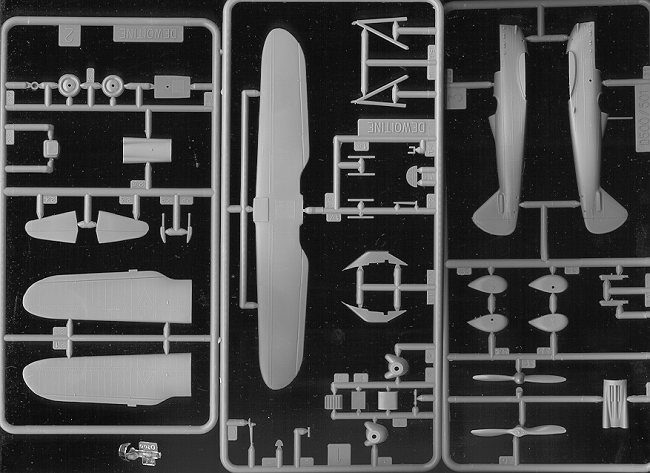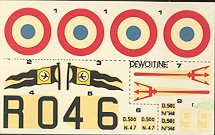
| KIT: | Heller 1/72 D.500/501 |
| KIT # | 156 |
| PRICE: | $ |
| DECALS: | Two aircraft |
| REVIEW & | |
| NOTES: | ` |

| HISTORY |
The Dewoitine D.500 series is basically the French equivalent to the P-26. It was the French Air Force's first production low wing, all metal, monoplane fighter. It was widely used not only in France, but versions were exported to other countries. Lithuania was one of those recipients when their D.372 fighters were given to the Spanish in 1935! The D.500 was powered by a 690 hp Hispano-Suiza 12 Xbrs that gave a top speed of 371 kph (around 250 mph). A later version was the D.501. The major difference was a motor mounted 20mm cannon in place of the twin machine guns. Externally the difference could be told by the lack of a prop spinner on the D.501. A later version with a three bladed prop and updated engine was the D.510.
| THE KIT |

Heller got its start by doing models of aircraft of French origin. All of their early kits were of such subjects and really added to the variety of models available in the late 1960's and early 1970's. Unfortunately, these were not some of the easiest kits to build, mostly due to general fit problems. Nothing that cannot be overcome, but something that modern modelers shy away from. And it is too bad as they are interesting subjects. Detailing is all of the raised panel line variety and is somewhat simplified as you can see from the toy-like wheels. Cockpit detail is your basic floor, seat, stick and instrument panel, though the panel has raised detail on it.
You get the optional parts to do either a D.500 or D.501. The D.500 gets the streamlined prop spinner and the cowl guns. The D.510 gets the clunkier prop and the underwing 20mm guns. From reports, the upper cowl does not fit well so keep that in mind when building it. The under fuselage radiator is a rather complicated construct of five pieces, though there is a good side view of how the pieces fit together.
 Instructions are a single exploded view with the two camo schemes shown in smaller boxes. These instructions are mainly in French though on the reverse side English and German translations are given. The D.500 is in olive and aluminum while the D.501 is overall aluminum. Decals are simple and, due to age, have rather badly yellowed carrier film. The tail tricolor will have to be painted on, which is probably for the best. Heller decals are pretty matte and generally do not work that well with the stronger setting solutions. I'd try an unused decal just to be sure they will work properly. Finding aftermarket ones will be a problem!!
Instructions are a single exploded view with the two camo schemes shown in smaller boxes. These instructions are mainly in French though on the reverse side English and German translations are given. The D.500 is in olive and aluminum while the D.501 is overall aluminum. Decals are simple and, due to age, have rather badly yellowed carrier film. The tail tricolor will have to be painted on, which is probably for the best. Heller decals are pretty matte and generally do not work that well with the stronger setting solutions. I'd try an unused decal just to be sure they will work properly. Finding aftermarket ones will be a problem!!
| CONCLUSIONS |
If you have an interest in the less usual and don't mind doing a bit of work to get a nice model, then this is for you. I have seen this kit built several times and it makes for an attractive little model. Just because it is old, does not mean it isn't worth your time and effort.
Review kit courtesy of me and my wallet!
If you would like your product reviewed fairly and fairly quickly by asite that has thousands of visits a day, please contactme or see other details in the